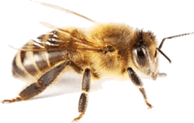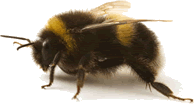
Recently I discovered that there are two different words for bee in Czech: čmelák [ˈʧmɛlaːk] (pl. čmeláci) for bumblebee and včela [ˈfʧɛla] (pl. včely) for honey bee. While investigating these words I also discovered the wonderful Czech word hmyz [ɦmɪz] (insect), which sounds like it might be onomatopoeic. This got me wondering about the differences between bumblebees and honey bees and the origins of these words.
Honey bees (apis) make and store honey, and live in large colonies in nests made from wax, while bumblebees (bombus) are bigger and hairier; make only a little honey for their young, and make much smaller nests [source 1 & source 2]. Honey bees are more likely to sting people than bumblebees, and lose their sting and die when they do so. Bumblebees are much less aggressive, very rarely sting people and don’t die when they sting [source].
The word bee can be traced back to the Proto-Indo-European root *bʰey-, via the Old English bēo [source], and the Czech word včela probably comes from the same root, via the Proto-Slavic *bьčela [source]. The word čmelák possibly comes from the same root as well, though I haven’t been able to find any confirmation of this.

Bumblebee was known humbul-be in Middle English and this was changed to sound like the Middle English word bombeln (to boom, buzz), which comes from the Proto-Indo-European root *kem (to hum) [source]. According to The Guardian though, bumblebees were known as humblebees because they hum. The name bumblebee had been around for many years and started to become more popular at the beginning of the 20th century, perhaps popularised by the name of the character Babbitty Bumble in Beatrix Potter’s Tale of Mrs Tittlemouse (1910).
Incidentally, a dialect word for bumblebee found in Hampshire, Cornwall and a number of other areas is dumbledore [source]. Dumbledore combines dumble, a dialect word from Southwell in Nottinghamshire meaning “a wood lined stream often in a small, steep sided valley” [source] and dore, of uncertain origin.
I’m not sure this is widespread across the world but French and German have two different names for the two kind of bees. In both cases honey bees are just “bees” while the bumblebees have an onomatopeoic name that doesn’t contain the “bee” word (“bourdon” and “Hummel” respectively). As an intersting side note, the lowest string on a banjo is known as a “bourdon” in French for the sound it makes.
I thought bumblebees didn’t have a sting at all?
In Dutch honey bees are also very much distinguished from bublebees, and given different names. A honey bee is called “een (honing)bij” (the “honing” is used sometimes to distinguish between several species of bee) en “een hommel” (which is obviously akin to the German word).
*buMblebees… I seem to keep forgetting to write the “m”.
I also see I forgot to write “and bumblebees are called…”
Actually, Max Vasmer explains Russian шмель (related to Czech čmelák) from Proto-Slav *čьmеl᾽ь “buzzing”, parallel to OHG humbal, modern German Hummel. So, basically, Germanic and Slavic languages use the same PIE name for bumblebee.
In addition to Jonathan, I can say the Dutch “bij” sounds the same as the original “bey”, and the first part of the Dutch “hommel” of course sounds like “hum”.
Polish makes the same distinction with pszczoła for honeybee and trzmiel for bumblebee. Colloquially a bumblebee can also be called bąk (an all purpose word which can also refer to herons, a kind of spinning top and … farts).
I was thinking I should start calling bumblebees hummmblebees from now on, but I think “bonk” is even better!
When I looked up “dumbledore” in the Oxford English Dictionary for my Harry Potter etymology site, it had “stupid, dull slow” for dumble and “humming insect” for dor.
Huh. I never even knew there was a difference between the two, I always thought they were the same thing. Thanks for teaching me something new!
Cheers,
Andrew
Early in the Sanskrit class I took many years ago, the professor introduced us to the lovely sentence (if I’ve remembered this correctly) madhukaraḥ madhunā mādyati, “the bee becomes drunk on honey.” All three words, as you can see, come from the same root.
Cognates include “mead” in English, words for “honey” in various languages (e. g. miel in French), and most interestingly, amethyst— from Greek for “not drunk” (the stone was believed to ward off drunkenness).
They are rather different in many ways. Bumblebees store little honey because only the queen survives the winter, so only enough food for one individual needs to be stored. They originated in temperate zones, whereas honeybees came from the tropics, and they are better adapted to the cold: a bumblebee can generate enough heat metabolically to fly on a cold day, but honeybees cannot, so they have to stay at home. (More exactly, both can _fly_ in cold weather, because the flying itself generates enough heat, but only bumblebees can _start_ flying.)
@ Andrew:
That’s interesting! A dutchman (or dutchkid, at least) might easily state ‘Huh. I never even knew there was a similarity between the two.’ To many of them, honey bees and bumble bees are as different as butterflies and dragonflies.
I always keep forgetting whether the Sapir-Whorff hypothesis asserts that language determines perception or vice versa, but in any case this seems a fitting opportunity to refer to it.
What about wasps and hornets? Are those the same?
jonas – the Czech for wasp is vosa, and hornet is sršeň.